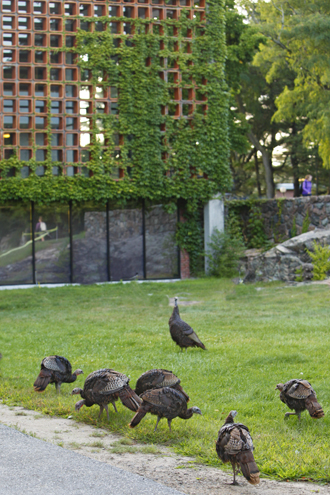From a fast day to a festival, Thanksgiving's unusual journey
Holiday was restored to national status by President Lincoln in 1863

'The First Thanksgiving,' by Jean Leon Gerome Ferris (1863-1930)
Macy’s is pushing its 86th annual parade extravaganza, entrepreneurs have made a Black Friday smartphone app to find the best shopping deals on the day after, and the Food Network has been serving up Thanksgiving menu proposals all month.
Would Sarah Josepha Hale be horrified or gratified?
Hale campaigned for 23 years in the mid-19th century to turn what had been a rather somber remembrance of America’s beginnings into a joyous, uniquely American celebration that began lighting up this dark season of the year during the depths of the Civil War.
“Thanksgiving was, for centuries, a very solemn day in New England,” says David Hackett Fischer, university professor and Earl Warren Professor of history. “It was to be a day of deep reflection and great seriousness.”
In the beginning, Thanksgiving could be either a feast or a fast day -- sometimes a feast to celebrate a blessing, sometimes a fast to seek guidance in a time of difficulty. There were sometimes numerous such days in a year. The first Thanksgivings did, as legend holds, involve both English settlers and Native Americans.
In his book “Thanksgiving: The Biography of an American Holiday,” James W. Baker writes the historical birth of the American Thanksgiving holiday took place in Plymouth in the fall of 1621.
According to Plimoth.org, a Smithsonian Institution affiliations program in Plymouth, Mass., the Continental Congress proclaimed the first national Thanksgiving, in 1777. Presidents Washington, Adams and Monroe also proclaimed national Thanksgivings, but that tradition faded by 1815 and the holiday was left to individual states to observe.

Sarah Josepha Hale, the editor of Godey’s Lady’s Book, began a campaign to reinstate the holiday in 1827, petitioning several presidents. She finally succeeded in 1863, when she was able to convince President Lincoln that a national Thanksgiving might serve to unite a war-torn country.
Lincoln declared two national Thanksgivings that year, one for August 6 celebrating the victory at Gettysburg and a second for the last Thursday in November.
In the late 19th century, says Fischer, New England the towns began holding their climactic football games on Thanksgiving. By the 1920s merchants began to take a hand, and in 1924 the Macy’s parade was born.
Franklin Roosevelt, with some urging from Macy’s retailing legend Fred Lazarus, moved the holiday to the fourth Thursday of November to stretch out the Christmas season in hopes that this would help the national economy. After much debate, Congress agreed, in 1941, to retain that timing.
Nowadays, Americans of all national origins celebrate Thanksgiving, many incorporating food and customs from their home countries into the melting pot.
“If my family were around I’d be looking forward to stuffing,” says Young Tae Seo ’15, who hails from Korea. “But this year, I’m going to be cooking for myself and friends who are on campus so that we can have our own little dinner.” Young will be cooking kimchi stew among other Korean treats.
Fischer says a student from Alabama once told him that an important tradition for her family was to have a bowl of magnolia blossoms on the table. One of his Jewish students shared that his family always served kugel as part of their Thanksgiving ritual.
“My family is German Lutheran,” says Fischer. Because of that, and in line with tradition in Maryland, his native state, “ sauerkraut is part of the day as well.”
For many Native Americans, however, Thanksgiving is a much more complicated day: a time to reflect upon the violence of colonial history, and on centuries of dispossession from land, language and culture. The holiday first came under sustained public attack by Native American activists in 1970. State officials vetted the text of an oration that Frank B. James, a Wampanoag leader, was slated to deliver at a banquet celebrating the 350th anniversary of the Mayflower's landing.
“Deeming James's impassioned narrative of stolen lands and broken promises off-key for the occasion,” writes Jane Kamensky, the Harry S. Truman Professor of American Civilization, in an article she published in Common-Place, the state leaders “promptly rescinded their invitation to break bread with him, thus inverting the very mythic, ancestral feast they were gathered to commemorate.”
James and other indigenous leaders staged a ritual of their own, covering Plymouth Rock with sand on what became the first National Day of Mourning.
Decades later, this annual commemoration of "un-Thanksgiving" continues on Cole’s Hill, above Plymouth Rock. It is organized by the United American Indians of New England (UAINE).
Such struggles over the holiday are hardly new, Kamensky notes. “Politics has always marched in the Columbus Day parade and taken a place on the Thanksgiving menu alongside the turkey, the stuffing, the kimchi, the kugel and more.”
Categories: General





